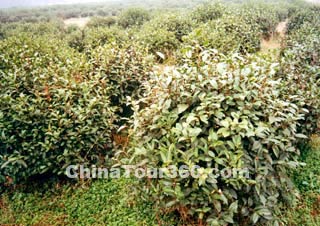 |
| Drinking Tea |
Nowadays, tea enjoys the fame as being the 'national drink' of China. Scientific research has proved that tea contains some biochemical elements which are closely related to the health of the human body, and that tea can refresh oneself, purify the heart, clear up summer heat, help in digestion, reduce phlegm, aid in weight loss, acts as an antidote to poison, sober up oneself, relieve thirst, benefit the eyes, and diarrhea. Additionally, tea has some pharmacological effect on some modern illnesses such as radiation sickness, geriatric cardiovascular and cerebrovascular disease and cancers. As a result, in China, the traditional tea is also made into food, beverage, medicine and other products. It is said that in the Tang Dynasty (618 - 907), the emperor asked a 130-year-old monk," what kind of medicine makes you live so long:" The monk replied, "I have never had any medicine but tea. I would ask for a cup of tea no matter where I arrive."
There are various ideas about the origin of Chinese tea. The most widespread one is that Chinese tea was discovered by Shennong, also called Yan Emperor the god who invented farming in ancient Chinese mythology, over 4,000 years ago. Folklore has it, that one day Shennong was boiling water in the open air when, unknown to him, leaves were blown into the boiler. When the water was boiled, he noticed that the water seemed yellowish and then he discovered that it helped relieve thirst and cooled and refreshed the head. According to past experience of tasting herbs, he concluded that the leaves must be a kind of medicine. Furthermore, Lu Yu of the Tang Dynasty (618-907) also wrote in his famous book Tea Classics that tea originated from Shennong.
As well as different varieties, tea is also classified into different grades. The common methods include feeling if it is dry enough and checking that the shape and color of the leaves are even. Also, colour of the liquid, aroma, taste and appearance of the infused leaf are also different when different grades of teas are brewed in hot water.

Trees of Tea
![]() Tea Classification - Tea can be divided into different categories according to different ways, but in China it is mainly classified into six categories namely - green, black, white, brick, scented and Oolong tea.
Tea Classification - Tea can be divided into different categories according to different ways, but in China it is mainly classified into six categories namely - green, black, white, brick, scented and Oolong tea.
![]() Tea Ware -Tea ware mainly includes tea pots, cups and bowls which are made from different materials, such as porcelain, pottery, clay, lacquer, bamboo, wood and glass.
Tea Ware -Tea ware mainly includes tea pots, cups and bowls which are made from different materials, such as porcelain, pottery, clay, lacquer, bamboo, wood and glass.







